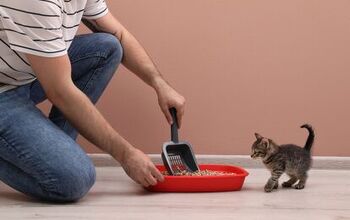How To Stop Cats From Scratching Furniture

The joy of having cats is incomparable to anything I’ve experienced. That said, cats can be troublemakers, and it can be quite frustrating when they scratch my furniture. Whether you’re a new cat parent or have had cats for years, you may struggle with how to stop cats from scratching your furniture.
The best way to stop cats from scratching furniture is to set up scratching posts throughout your house. You can also discourage them from scratching furniture if you apply double-sided tape instead furniture guards. Make sure to trim your cat’s nails every 2-3 weeks or as needed and train your cat with positive reinforcement to discourage scratching.
Play with your cats each day to help them expend energy, so they’re less likely to scratch your furniture and carpets. Follow along as we explore how to stop cats from scratching furniture.
8 Ways To Stop Cats From Scratching Furniture
Whether it be training them or setting up scratching posts, you can distract your cats from scratching furniture in several ways. Luckily, there are 8 inexpensive ways to protect your furniture from your cats.
1. Buy Scratching Posts
Cats naturally love to scratch whether it be because they’re excited, stressed, or marking their territory. Scratching posts give them an outlet for scratching that helps stop them from scratching furniture. At first, they may keep scratching your furniture while also scratching the posts.
However, you can curb that behavior if you clap or gently spray them with water when they scratch your furniture. Make sure to encourage or reward them when they scratch the post, so they know it’s okay to do that. I recommend that you put several scratching posts throughout different parts of your home.
This will give them several spots to scratch and vent, so they don’t take their energy out on your furniture. Standard cat scratching posts cost between $15 and $60, but high-end cat trees with posts cost up to $200.
2. Trim Their Nails
Trim your cat's nails to stop them from scratching everything from furniture and window screens to your carpet and clothing. Ideally, you should trim your cat’s nails every 2-3 weeks, so they stay at the perfect length. An older cat’s nails may grow back slowly, so you may only need to trim their nails once per month.
Avoid trimming their nails too short to where it could cause them discomfort. However, you may not even need to trim your cat’s nails if they maintain their nails well without your help. Cats are naturally inclined to bite their nails, but it’s worth trimming their nails if they continue scratching your furniture.
Make sure to pet your cat and cuddle with them before you trim their nails, so they are calm and comfortable. Use sharp clippers and only trim the tip of the claws so you don’t hurt them. This will also keep their nails smooth and even, so they don’t get stuck on your floor, clothes, and furniture. Give them a treat when you’re done as a reward!
3. Nail Caps
Vinyl nail caps make it easy to stop cats from scratching furniture, but you must reapply them regularly. These cat claw covers only last for 5 weeks on average, but they can last 6-7 weeks in some cases. Cat nail caps either come with adhesive that you apply to their nails, or they come with the adhesive already inside them.
You simply attach each nail cap one at a time, hold it there for a few seconds, and move on to the next one. It only takes a few seconds for the caps to bond to the nail, and they don’t cause the cat any discomfort. Over time, the adhesive will weaken, and they will eventually fall off.
Don’t be surprised if your cat bites and plays with the caps at first. It only took my cat a day or two to get used to his nail caps, and he acted normal after that. I recommend using caps that come with adhesive already applied, but I have also had to apply adhesive manually. They don’t hurt your cat, and you won’t have to worry about them scratching furniture again!
4. Use Furniture Guards
Furniture guards serve as scratching posts that protect your furniture. They have a similar texture to scratching posts and they fit perfectly onto the corner of your couch. Sofa-Scratcher is one of the top cat furniture guard brands, and they come in several colors.
Make sure to look for a furniture guard that fits the shape of your couch. Many furniture guards are shaped like right angles, and that isn’t ideal for every piece of furniture. If you can’t find one that fits your couch, you can always make a DIY furniture guard.
Sisal rope is one of the best materials for a scratching post. Luckily, you can easily shape sisal rope to where it fits the sides or corners of your furniture.
5. Train Your Cat
It’s harder to train cats than dogs, but it is possible. The best way to train a cat is to give them positive or negative reinforcement based on their behavior. For example, when you first get a cat, you should reward them for good behavior, such as using the litter box, so they know to continue to do it.
However, you must also show them that they are behaving wrong when they do bad things, such as scratching your furniture. Never hurt your cat, but simple tactics like clapping your hands together and raising your voice can let them know when it’s time to stop.
Clap your hands, gently spray them, or loudly say your cat’s name each time they scratch your furniture. Over time, they will eventually stop scratching your furniture if you are consistent with your reinforcement.
6. Keep Them Active
Cats are energetic animals, and they need to stay active. When they are bored or feel neglected, they lash out in many ways, including scratching furniture. Play with your cats as often as possible to help them expend energy, so they are less likely to act out.
Ideally, you should play with your cat for at least 20 minutes per day. I try to play with my cat in the morning before work and again at night for as long as possible. Not only is it fun for me, but it also makes my cat act much calmer and less destructive throughout the day.
7. Double-Sided Tape
Double-sided tape is the best DIY method for stopping your cats from scratching furniture. The sensation of scratching something covered in double-sided tape doesn’t give cats the same satisfaction. Because of that, they will instead switch to scratching the designated posts in your house.
Simply wrap the parts of your furniture that they typically scratch with double-sided tape to discourage the bad behavior. Luckily, double-sided tape is clear, so you won’t obscure your furniture’s appearance too much.
8. Floor Scratcher
Some cats love to scratch carpets as much as furniture. If that’s the case in your home, I recommend that you buy a floor scratcher. They are textured the same way as scratching posts, but they sit on the floor.
Floor scratchers typically cost $8 to $20 and sit on the floor. They come in several sizes and are just as effective as scratching posts in my experience.
Should You Declaw A Cat?
You should never declaw a cat. Not only is it illegal in some states, but it can also cause your cat to have chronic pain. Declawing can cause the tissue in a cat’s paw to die in many cases, and that is quite painful and dangerous.
They can also get bone spurs and suffer lifelong nerve damage when you declaw them. It’s illegal to declaw cats in states like New York, and other states, like Illinois, impose fines of up to $2,500.
Summing It Up
The best way to stop cats from scratching furniture is to set up scratching posts for them to scratch instead. You can protect your furniture from scratches if you cover the sections that they scratch the most with double-sided tape. It also helps to play with your cat for 20 minutes or more per day and use a squirt bottle to train them to stop scratching your furniture.
Related Guides

Nick Durante is a professional writer with a primary focus on home improvement. When he is not writing about home improvement or taking on projects around the house, he likes to read and create art. He is always looking towards the newest trends in home improvement.
More by Nick Durante



























